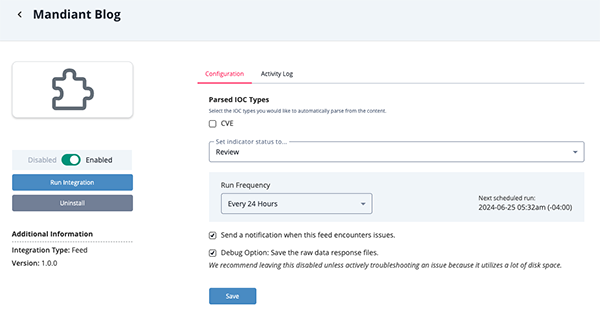Mandiant Blog CDF
The web format of this guide reflects the most current release. Guides for older iterations are available in PDF format.
Integration Details
ThreatQuotient provides the following details for this integration:
| Current Integration Version | 1.0.0 |
| Compatible with ThreatQ Versions | >= 5.24.1 |
| Support Tier | ThreatQ Supported |
Introduction
The Mandiant Blog CDF enables analysts to automatically ingest blog posts from the Mandiant website. This allows analysts to stay up-to-date on advisories, bulletins, and analyses from the Mandiant team.
The integration provides the following feed:
- Mandiant Blog - pulls blog posts from the Mandiant website and ingests them into ThreatQ as Report Objects.
The integration ingests report and indicator type system objects.
Installation
Perform the following steps to install the integration:
The same steps can be used to upgrade the integration to a new version.
- Log into https://marketplace.threatq.com/.
- Locate and download the integration yaml file.
- Navigate to the integrations management page on your ThreatQ instance.
- Click on the Add New Integration button.
- Upload the integration yaml file using one of the following methods:
- Drag and drop the file into the dialog box
- Select Click to Browse to locate the file on your local machine
- Select the individual feeds to install, when prompted and click Install.
ThreatQ will inform you if the feed already exists on the platform and will require user confirmation before proceeding. ThreatQ will also inform you if the new version of the feed contains changes to the user configuration. The new user configurations will overwrite the existing ones for the feed and will require user confirmation before proceeding.
The feed(s) will be added to the integrations page. You will still need to configure and then enable the feed.
Configuration
ThreatQuotient does not issue API keys for third-party vendors. Contact the specific vendor to obtain API keys and other integration-related credentials.
To configure the integration:
- Navigate to your integrations management page in ThreatQ.
- Select the OSINT option from the Category dropdown (optional).
If you are installing the integration for the first time, it will be located under the Disabled tab.
- Click on the integration entry to open its details page.
- Enter the following parameter under the Configuration tab:
Parameter Description Parsed IOC Types Select the IOC type to parse from the content ingested. Currently, the only type available is CVE.

- Review any additional settings, make any changes if needed, and click on Save.
- Click on the toggle switch, located above the Additional Information section, to enable it.
ThreatQ Mapping
Mandiant Blog
The Mandiant Blog feed pulls blog posts from the Mandiant website and ingests them into ThreatQ as Report Objects.
GET https://www.mandiant.com/views/ajax?_wrapper_format=drupal_ajax
The output of this request is JSON which contains a field with the HTML for the page of blogs. The HTML is parsed for blog links and the links are fetched.
GET https://www.mandiant.com/resources/blog/{{ uri }}
ThreatQuotient provides the following default mapping for this feed:
| Feed Data Path | ThreatQ Entity | ThreatQ Object Type or Attribute Key | Published Date | Examples | Notes |
|---|---|---|---|---|---|
| N/A | Report.Title | N/A | N/A | Trojanized Windows 10 Operating System Installers Targeted Ukrainian Government |
Parsed from the HTML |
| N/A | Report.Published_At | N/A | N/A | N/A | Parsed from the HTML |
| N/A | Report.Attribute | External Reference | N/A | https://www.mandiant.com/resources/ |
Parsed from HTML |
| N/A | Report.Attribute | Published At | N/A | DEC 15, 2022 |
Parsed from the HTML |
| N/A | Report.Tag | N/A | N/A | Ransomware |
Parsed from the HTML |
| N/A | Report.Description | N/A | N/A | <HTML content> |
Parsed from the HTML |
| N/A | Report.Indicator | CVE | N/A | CVE-2023-41232 |
Parsed from HTML |
Average Feed Run
Object counts and Feed runtime are supplied as generalities only - objects returned by a provider can differ based on credential configurations and Feed runtime may vary based on system resources and load.
| Metric | Result |
|---|---|
| Run Time | 1 minute |
| Reports | 27 |
| Report Attributes | 54 |
| Indicators | 3 |
Known Issues / Limitations
- In order to avoid re-ingesting data, the feed uses the
sinceanduntildates. - If you'd like to fetch historical data, you can run the feed manually, setting the
sincedate to the desired date. - The max number of pages of posts the feed will fetch is 3.
Change Log
- Version 1.0.0
- Initial release
PDF Guides
| Document | ThreatQ Version |
|---|---|
| Mandiant Blog CDF Guide v1.0.0 | 5.24.1 or Greater |